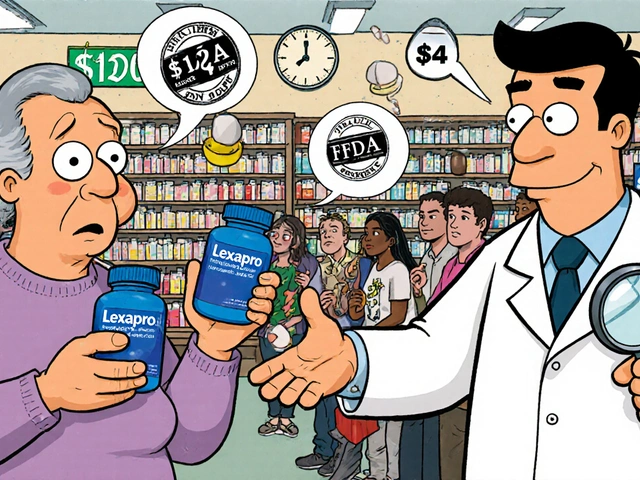Calcium Channel Blocker Comparison Tool
Select a drug to compare its key attributes with others:
Quick Summary
Select a drug to view its quick summary.
Adalat is a brand‑name formulation of nifedipine, a dihydropyridine calcium channel blocker used to treat hypertension and angina pectoris. It works by relaxing vascular smooth muscle, lowering blood pressure, and improving coronary blood flow
If you’ve been prescribed a pill for high blood pressure or chest pain, chances are you’ve heard the name Adalat. But the market is crowded with similar‑acting drugs, and each has its own quirks. This guide walks you through the most common alternatives, highlights where they overlap, and points out the subtle differences that matter when you or a loved one decide which medication fits best.
Quick Takeaways
- Adalat (nifedipine) is fast‑acting, good for acute angina, but can cause sudden drops in blood pressure.
- Amlodipine offers once‑daily dosing and a smoother blood‑pressure curve.
- Felodipine is similar to amlodipine but with a slightly shorter half‑life.
- Verapamil and diltiazem also block calcium, yet they affect heart rate more than nifedipine.
- Choosing the right drug depends on indication, side‑effect tolerance, and other medicines you take.
How Adalat (Nifedipine) Works
Nifedipine belongs to the calcium channel blocker class. By inhibiting L‑type calcium channels in arterial smooth muscle, it prevents calcium influx, which relaxes vessels and reduces peripheral resistance. The result is lower systolic and diastolic pressure. In the coronary arteries, the same relaxation eases the heart’s oxygen demand, relieving angina.
The drug is available in immediate‑release (IR) and extended‑release (ER) tablets. The IR form peaks within 30‑60 minutes, making it useful for sudden chest‑pain episodes, while ER provides steadier levels for chronic hypertension.
Key Alternatives to Consider
Below are the most frequently prescribed replacements, each with its own pharmacologic profile.
Amlodipine is a long‑acting dihydropyridine calcium channel blocker that offers a once‑daily dose, a half‑life of about 35‑50 hours, and a lower incidence of reflex tachycardia than nifedipine.
Felodipine shares the dihydropyridine backbone with amlodipine but is metabolized faster, giving a half‑life of roughly 11‑16 hours and requiring once‑daily dosing for most patients.
Verapamil is a phenylalkylamine calcium channel blocker that affects both vascular smooth muscle and the cardiac conduction system, often resulting in a slower heart rate and useful in certain arrhythmias.
Diltiazem sits between dihydropyridines and phenylalkylamines; it modestly reduces heart rate while still providing vasodilation, making it a hybrid choice for patients with hypertension plus atrial fibrillation.
Comparative Snapshot
| Drug | Class | Typical Dose | Half‑life (hrs) | Primary Indication | Common Side‑effects |
|---|---|---|---|---|---|
| Adalat (Nifedipine) | Dihydropyridine CCB | 30‑60 mg ER daily | 2‑5 (IR) / 6‑9 (ER) | Hypertension, angina | Headache, flushing, peripheral edema |
| Amlodipine | Dihydropyridine CCB | 5‑10 mg daily | 35‑50 | Hypertension, chronic angina | Swelling, dizziness, gum overgrowth |
| Felodipine | Dihydropyridine CCB | 5‑10 mg daily | 11‑16 | Hypertension | Headache, flushing, edema |
| Verapamil | Phenylalkylamine CCB | 80‑240 mg daily | 3‑7 | Hypertension, arrhythmias | Constipation, bradycardia, AV block |
| Diltiazem | Benzothiazepine CCB | 120‑360 mg daily | 3‑5 | Hypertension, angina, atrial fibrillation | Fatigue, edema, liver enzyme rise |

Factors to Weigh When Picking a Calcium Channel Blocker
Every drug sits on a balance sheet of benefits vs. drawbacks. Below are the most critical decision points.
- Indication specificity: If you need rapid relief from an angina flare‑up, the IR version of nifedipine (Adalat) excels. For stable, long‑term blood‑pressure control, amlodipine’s smooth profile is preferred.
- Heart‑rate impact: Patients with pre‑existing bradycardia should avoid verapamil and diltiazem, which can further slow the pulse. Nifedipine, a pure vasodilator, generally spares heart rate.
- Drug‑interaction risk: CYP3A4 inhibitors (e.g., grapefruit juice, macrolide antibiotics) raise levels of nifedipine, amlodipine, and felodipine. Verapamil and diltiazem also interact with digoxin and beta‑blockers.
- Side‑effect tolerance: Peripheral edema is a hallmark of dihydropyridines (nifedipine, amlodipine, felodipine). If swelling is unacceptable, a non‑dihydropyridine like verapamil may be kinder.
- Dosing convenience: Once‑daily regimens improve adherence. Amlodipine and felodipine both offer that simplicity, whereas immediate‑release nifedipine may need multiple daily doses.
Real‑World Scenarios
Scenario 1 - Acute Chest Pain: Jane, a 58‑year‑old with intermittent angina, visits urgent care after a sudden pressure sensation. The clinician chooses immediate‑release nifedipine (Adalat) for its rapid onset, giving relief within an hour.
Scenario 2 - Chronic Hypertension with Diabetes: Mark, 62, struggles with blood‑pressure control despite lifestyle changes. His doctor opts for amlodipine because it does not interfere with his metformin, has a low risk of worsening glucose control, and offers a convenient once‑daily pill.
Scenario 3 - Hypertension + Atrial Fibrillation: Lucy, 70, is on a beta‑blocker for rhythm control but still has high pressure readings. Diltiazem is selected for its modest rate‑slowing effect, complementing the beta‑blocker without causing excessive bradycardia.
Potential Pitfalls & How to Avoid Them
Even well‑chosen meds can trip you up. Keep an eye on these common issues.
- Sudden blood‑pressure drops: Nifedipine IR can cause a rapid fall, especially if taken on an empty stomach. Mitigate by starting with a low dose and eating a small snack.
- Drug‑interaction surprises: Grapefruit juice can spike levels of most dihydropyridines. Advise patients to skip grapefruit while on therapy.
- Unwanted swelling: Peripheral edema often signals excess fluid accumulation. Switching to a non‑dihydropyridine or adding a low‑dose diuretic can bring relief.
- Heart‑rate changes: Verapamil may cause bradycardia. Monitor pulse after initiation, especially in patients already on beta‑blockers.
Related Concepts Worth Exploring
Understanding calcium channel blockers fits into a broader cardiovascular toolkit. Other drug families that frequently intersect with CCB therapy include:
- ACE inhibitors - popular first‑line agents for hypertension and heart‑failure. \n
- Beta‑blockers - often combined with CCBs for angina control.
- Diuretics - useful adjuncts for edema caused by CCBs.
Exploring these connections helps you see why a clinician might stack medications or rotate between classes based on your response.
Frequently Asked Questions
Can I switch from Adalat to amlodipine without a doctor's approval?
No. Although both are calcium channel blockers, they differ in dosing, half‑life, and side‑effect profile. A physician should assess your blood‑pressure trends, other meds, and any history of edema before making the change.
Why does nifedipine sometimes cause a sudden headache?
The rapid vasodilation of blood vessels in the brain can briefly increase blood flow, triggering a headache. Taking the drug with food or switching to the extended‑release form often reduces this effect.
Is verapamil safe for someone with asthma?
Verapamil does not directly affect the lungs, but because it can lower heart rate, it may exacerbate exercise‑induced breathlessness. Discuss alternatives like amlodipine with your pulmonologist if asthma is a concern.
How does diltiazem differ from nifedipine in heart‑rate control?
Diltiazem partially blocks calcium channels in the heart, slowing the sinus node and AV conduction, which can lower heart rate. Nifedipine primarily targets vascular smooth muscle, leaving heart rate largely unchanged.
What monitoring is needed after starting a calcium channel blocker?
Doctors usually check blood pressure and heart rate within the first week, then again after 2-4 weeks to adjust dosage. Lab tests for liver enzymes are recommended for verapamil and diltiazem, while a basic metabolic panel suffices for dihydropyridines.






Michael Vincenzi
September 27, 2025 AT 17:42Just wanted to chime in and say that the comparison tool does a solid job of laying out the key differences between nifedipine and the other CCBs, especially for folks trying to pick the right pill for their health goals.
Courage Nguluvhe
September 30, 2025 AT 01:15The pharmacodynamic profile delineated herein underscores the higher vascular selectivity of dihydropyridines such as nifedipine, which translates clinically into pronounced peripheral vasodilation and consequent orthostatic hypotension risk, whereas non‑dihydropyridine agents like verapamil exert a more pronounced negative chronotropic effect due to their affinity for myocardial L‑type calcium channels.
Alissa DeRouchie
October 2, 2025 AT 08:48Wow this table blew my mind the side‑effect landscape is practically a battlefield each drug shouting its own complaints from headaches to bradycardia and I can’t help but wonder why nobody mentions the emotional toll of constant swelling on patients’ confidence
Emma Howard
October 4, 2025 AT 16:22Hey everyone let’s give a big shout‑out to the folks who put this together!!! It really makes choosing between Adalat and its cousins a lot less intimidating!!!
dee gillette
October 6, 2025 AT 10:02While the enthusiasm is appreciated, a more dispassionate analysis reveals that the presented data omit considerations of cost-effectiveness and patient adherence patterns, factors that are arguably as pivotal as pharmacologic characteristics in real‑world decision‑making.
Jasin P.
October 8, 2025 AT 17:35One could argue that the United States’ penchant for blockbuster drugs has turned nifedipine into the celebrity of calcium channel blockers, yet the chemistry remains indifferent to borders and politics.
Lily Đàn bà
October 10, 2025 AT 11:15Honestly the drama surrounding “American” drug superiority is exhausting; the truth is that verapamil and diltiazem have their own merits and should not be dismissed as second‑rate simply because they hail from different pharma pipelines.
Joseph O'Sullivan
October 12, 2025 AT 18:48Honestly mate the tool’s slick UI is cool but if you’re actually on a tiny screen you’ll miss half the table – maybe a mobile‑friendly version would save a lot of eye‑strain.
Conor McCandless
October 15, 2025 AT 02:22When you sit down to compare calcium channel blockers, the first thing that should strike you is the sheer diversity of therapeutic niches each compound occupies. Nifedipine, marketed as Adalat, is celebrated for its rapid vasodilatory action, making it the drug of choice for acute angina episodes where minutes matter. Its immediate‑release formulation can drop systolic pressure within half an hour, a feature that no other dihydropyridine can reliably claim. However, this very potency is a double‑edged sword, as the sudden drop may precipitate reflex tachycardia or dizziness in susceptible patients. On the other hand, amlodipine offers a smoother, once‑daily dosing schedule that minimizes peaks and troughs, translating into more stable blood‑pressure control over 24 hours. The half‑life of amlodipine, extending up to 50 hours, also reduces the need for strict adherence, an advantage for patients with chaotic lifestyles. Felodipine occupies an intermediate position, delivering efficacy comparable to amlodipine but with a slightly shorter half‑life that may be preferable for those who experience edema on longer‑acting agents. Verapamil diverges from the dihydropyridine class by targeting cardiac conduction, thereby reducing heart rate and proving useful in certain arrhythmias, yet this same property can limit its use in patients with existing bradycardia. Diltiazem, the hybrid of the class, provides moderate vasodilation while also exerting modest rate‑control, making it a versatile option for hypertension complicated by atrial fibrillation. Clinicians must also weigh the metabolic pathways; nifedipine, amlodipine, and felodipine are all metabolized by CYP3A4, opening the door for interactions with common culprits like grapefruit juice. In contrast, verapamil and diltiazem have additional interactions with digoxin and beta‑blockers that demand careful monitoring. Side‑effect profiles further differentiate the drugs: peripheral edema is a hallmark of dihydropyridines, whereas constipation and AV‑block are more typical of verapamil. Patient‑specific factors such as comorbid diabetes, renal function, and tolerability thresholds ultimately dictate the optimal choice. Therefore, rather than viewing these agents as interchangeable, think of them as a palette of colors from which the physician can paint the most suitable therapeutic picture. Finally, regular follow‑up and laboratory monitoring, especially liver enzymes for verapamil and diltiazem, ensure that the chosen regimen remains both safe and effective.
kat gee
October 16, 2025 AT 20:02So basically, if you like simplicity pick amlodipine, if you enjoy drama pick nifedipine – thanks for the crystal‑clear guide.
Iain Clarke
October 19, 2025 AT 03:35For anyone still confused, a quick tip: always check whether your prescription is immediate‑release or extended‑release, because the dosing frequency and side‑effect risk differ dramatically between the two formulations.
Courtney Payton
October 20, 2025 AT 21:15It is questionable whether the author’s emphasis on dosing convenience sufficiently addresses the ethical implications of prescribing costlier extended‑release formulations to patients with limited insurance coverage.
Muthukumaran Ramalingam
October 23, 2025 AT 04:48Look I get that the table is nice and all but honestly most of us just skim the headings and pick the drug that our doctor handed us, so spending all this time analyzing half‑lives feels like overkill when you could just trust your physician’s judgment.
Garrett Williams
October 24, 2025 AT 22:28Great job on the tool it really helps people make better choices keep it up
Charmaine De Castro
October 27, 2025 AT 05:02The colorful breakdown of side‑effects reminds me of a painter’s palette – each drug adds its own hue to the overall picture of cardiovascular management, and that visual metaphor makes the data far more memorable.
Kenneth Obukwelu
October 28, 2025 AT 22:42In the grand theatre of medicine, calcium channel blockers play the roles of both protagonists and antagonists, their mechanisms weaving a narrative that challenges our understanding of vascular physiology and human resilience.
Josephine hellen
October 30, 2025 AT 16:22Indeed, when we consider the patient’s journey, the choice of a CCB becomes more than a pharmacologic decision; it becomes an act of hope, a promise that we can alleviate pain and lower risk, and that optimism fuels adherence, encouraging patients to stay the course despite occasional edema or flushing, because they see the larger picture of a healthier heart and longer life, and that perspective transforms a simple prescription into a partnership between clinician and patient, fostering trust and shared responsibility.
Ria M
November 1, 2025 AT 10:02The drama doesn’t end with the pharmacokinetics – the real showdown happens in the clinic where doctors must juggle insurance formularies, patient preferences, and the ever‑looming specter of side‑effects, making every prescription a high‑stakes performance!
Oliver Bishop
November 3, 2025 AT 03:42American labs sure love pushing Adalat hard.